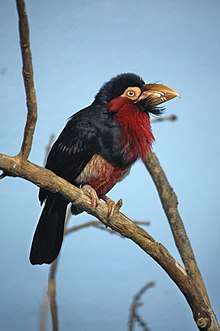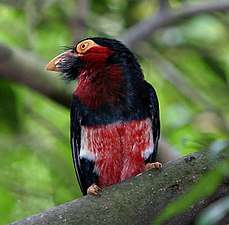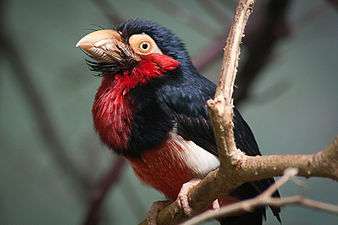Bearded barbet
The bearded barbet (Lybius dubius) is an African barbet. Barbets and toucans are a group of near passerine birds with a worldwide tropical distribution. The barbets get their name from the bristles which fringe their heavy bills.
| Bearded barbet | |
|---|---|
 | |
| Bearded barbet at Denver Zoo, Colorado | |
| Scientific classification | |
| Kingdom: | Animalia |
| Phylum: | Chordata |
| Class: | Aves |
| Order: | Piciformes |
| Family: | Lybiidae |
| Genus: | Lybius |
| Species: | L. dubius |
| Binomial name | |
| Lybius dubius Gmelin, 1788 | |
The bearded barbet is a common resident breeder in tropical west Africa. It is an arboreal species of gardens and wooded country which eats fruit, although the young are fed on insects. It nests in a tree hole, laying 2 white eggs.
This is a conspicuous, large barbet at 26 centimetres (10 in). It is fairly plump, with a short neck, large head and a shortish tail. The adult has a black crown, back, tail and breast band. The throat and belly are red and there is a yellow eye patch. The rump is white. The massive bill is very thick and yellow, and the well developed clump of bristles at its base give the species its name. Sexes are similar. The call is a growling scrawk.
The bearded barbet is found in well-wooded areas with plentiful fig trees. It will enter gardens for fruit. It forms social groups of 4-5 birds and pairs or groups roost together in a tree cavity.
Gallery

 Head and "beard"
Head and "beard" At Warsaw Zoo, Poland
At Warsaw Zoo, Poland
References
- BirdLife International (2012). "Lybius dubius". IUCN Red List of Threatened Species. 2012. Retrieved 26 November 2013.CS1 maint: ref=harv (link)
- Birds of The Gambia by Barlow, Wacher and Disley, ISBN 1-873403-32-1
External links

